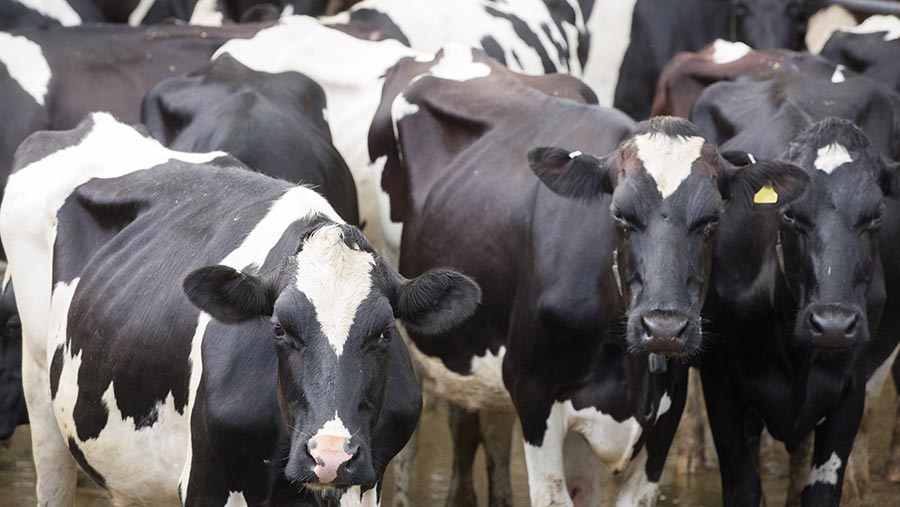Outlook 2017: Volatility likely to remain for dairy sector
 © Tim Scrivener
© Tim Scrivener The extreme price volatility seen over the past 12 months has at least ended the year on the right note.
Farmgate prices continue to move upwards, though for some dairy farms there is a way to go before they reach profitable levels.
“Dairy business profits are under pressure for the second year running and stock sales have been used to raise cash. Reinvestment will have been nil or negligible,” says Tony Evans, Andersons head of farm business consultancy.
The first half of 2016 saw a continued decline in farmgate milk prices because of strong production and weak world dairy commodity prices. The subsequent rise in the second half of the year is partly a legacy of the very low spring prices, says Mr Evans.
Business pointers
- Establish robust milk supply forecasts
- Consider switching production systems
- Ensure management is top-notch
- Low interest rates provide opportunity for prudent investment
- Work on attracting and keeping the right staff
“These drove many producers to hold off using purchased feed when it was only producing milk generating a low ‘B’ price. This, combined with a sudden fall-off in grass quality in May and June, has resulted in milk supplies falling below demand.”
See also: Opportunities remain in a subdued renewables sector
UK milk production in autumn 2016 was running about 8-9% lower than the previous year. This pushed spot milk prices from 16p to close to 40p in a six-month period.
Long-term strategies
To avoid such discrepancies, milk buyers need to have better long-term strategies, communicate their supply requirements to farmers more effectively and have a greater understanding of what is happening on farm, says Mr Evans.
“At the same time, milk producers need to take their supply forecasts seriously – albeit for many it has been a very depressing time and therefore to remain positive can be difficult.”
Many milk producers are now switching to more profitable production systems, moving away from year-round to seasonal calving, says Mr Evans.
“Costings data in the UK indicate that year-round calving has the highest outlay,” he adds. “Without retailer support, these businesses are losing money.”
Spring-calving herds with a large proportion of “B” quota have also had a tough year, but may have been able to at least break even, says Mr Evans.
Autumn-calving herds will have had a reasonable 2016 as the milk price rises in the second half of the year coincided with increased volumes produced.
“However, the average-quality silage made this year, due to a late, cold spring, will make it a challenge for many to produce cheaper litres from forage.”
Polarised UK dairy sector
Within an increasingly polarised UK dairy sector, there will still be a place for high-yielding systems, but only if the management is of the very best quality, says Mr Evans.
The use of genomics in the future may see the 14,000-litre dairy cow become a reality. But consumer reaction to such developments needs to be watched carefully, he adds.
Prudent borrowing
With low interest rates there is a case for prudent long-term borrowing to fund investment. “The emphasis must be on the word prudent – some of those businesses that have struggled the most in the recent downturn are those that expanded with business plans predicated on a milk price in excess of 30p/litre,” says Mr Evans.
Milk price rises of the autumn will come just a bit too late for a number of dairy businesses. Even though values have risen, with the likelihood of more to come, the losses will still be accruing at current milk prices.
“The rise in cow values that has accompanied the milk price rises may persuade some that this is a good time to exit, simply because they are short of cash,” says Mr Evans.
Looking ahead, the opportunity for businesses to sell product to the UK’s 66 million customers is very strong, he believes.
“The UK is not self-sufficient in milk and milk products and, post-Brexit, there is huge scope for milk processors to compete with imported food.”
However, farm production systems must continue to adapt.
“The right systems, staffed by the right people, are essential to establish lower-capital, lower-cost, resilient businesses that can produce top-quality raw material for a supply chain in which all parts can prosper.”
Farmers Weekly says:
Rhian Price, deputy livestock editor
- Growing emphasis will be put on antibiotics in 2017, with milk buyers likely to demand restricted use of certain ones. There has already been a move towards this in the drying-off phase, with producers encouraged to use dry cow therapy.
- Volatility is here to stay, so it’s about making small changes that add up to a big difference. Healthy animals are key to this – tackling infectious diseases such as Johne’s and BVD will have big effects as national initiatives gather pace.
- Producers will have to improve their output forecasting as buyers seek better predictions
Andersons Outlook
The Farmers Weekly outlook articles are based on Andersons Outlook 2017. Copies of the full publication can be downloaded from the Andersons website by clicking on ‘Publications & Events’. Alternatively, request a printed copy by telephoning 01664 503 200.
Andersons is running a series of seminars in the spring looking at the prospects for UK agriculture in greater detail.
3 March – RAF Club, Piccadilly, London
7 March – Harper Adams University, Newport, Shropshire
8 March – Westmorland, J36 Auction Centre, Kendal
9 March – Carfraemill Lodge Hotel, Lauder, Berwickshire
10 March – York Racecourse, York, North Yorkshire
14 March – Yew Lodge Hotel, Kegworth Leicestershire
15 March – Perth Racecourse, Perth
17 March – Newmarket Racecourse, Newmarket, Suffolk
21 March – East of England Showground, Peterborough, Cambridgeshire
22 March – Salisbury Racecourse, Salisbury, Wiltshire
23 March – Exeter Racecourse, Exeter, Devon
24 March – Royal Agricultural University, Cirencester, Gloucestershire
